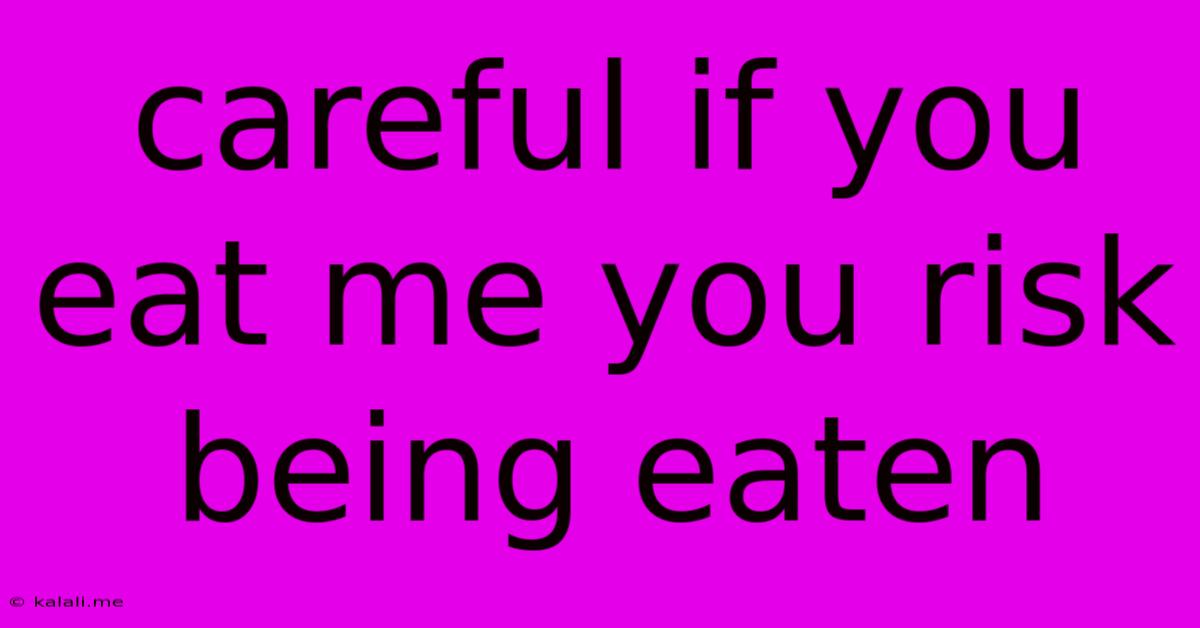Careful If You Eat Me You Risk Being Eaten
Kalali
May 28, 2025 · 3 min read

Table of Contents
Careful If You Eat Me: You Risk Being Eaten! (A Deep Dive into Predator-Prey Relationships)
Meta Description: Discover the fascinating world of predator-prey relationships! Learn about the surprising ways seemingly harmless creatures can become deadly meals, and how the risk of being eaten is a constant factor in the natural world. This article explores various examples, from microscopic parasites to apex predators.
The natural world is a constant game of survival, a delicate balance where life feeds on life. This intricate dance of predator and prey is often brutal, but undeniably fascinating. While we might think of apex predators like lions and sharks as the primary dangers, the reality is that the risk of being eaten permeates every level of the food web, even impacting seemingly insignificant organisms. This article delves into this captivating reality, exploring how the adage "careful if you eat me, you risk being eaten" applies across diverse ecosystems.
The Microscopic Battleground: Parasites and Their Hosts
We often overlook the microscopic world, but it’s teeming with life-and-death struggles. Many single-celled organisms and parasites exemplify the "eat me, risk being eaten" principle perfectly. Consider a microscopic parasite that infects an insect. While the parasite benefits from consuming the insect's resources, it also makes the insect weaker and more vulnerable to other predators. The parasite, in essence, increases the risk of its own demise by making its host an easier meal. This is a fundamental aspect of ecological interactions – the survival of the parasite is intrinsically linked to the survival of its host, at least until reproduction is complete.
The Sneaky Deception: Camouflage and Mimicry
Many animals employ clever strategies to avoid becoming prey, often involving deception. Camouflage, where an animal blends seamlessly with its environment, is a classic example. But what if this camouflage is itself a predatory tactic? Certain species utilize camouflage to ambush their prey, highlighting the cyclical nature of predation. For example, a leaf-mimicking insect can hide itself and then capture an unsuspecting insect, only to later become prey itself to a larger predator. Mimicry, where one species imitates the appearance of another, also plays a vital role in this delicate balance. A harmless insect mimicking a poisonous one can deter predators, but it still risks being eaten if the mimicry is imperfect or the predator is discerning.
The Apex Predators: The Ultimate Risk
At the top of the food chain reside the apex predators – animals with few or no natural predators. These magnificent creatures are often the epitome of the "eat me, risk being eaten" concept, albeit on a larger scale. Although they rarely face the risk of becoming prey themselves, their lives are constantly defined by the challenge of securing food. Their hunting strategies, their social structures, and even their physical adaptations are all tailored towards maximizing their chances of survival while minimizing the risk of injury during the hunt. Even apex predators face challenges, such as starvation, territorial disputes, and disease—all of which underscore the precariousness of life even at the pinnacle of the food web.
The Constant Cycle: A Web of Interdependence
The predator-prey dynamic is a fundamental cornerstone of ecological balance. It regulates populations, preventing any single species from becoming overly dominant. This dynamic isn't a linear progression; it's a complex web of interactions where the "risk of being eaten" is a constant factor. Understanding this intricate relationship is essential for comprehending the delicate ecosystems that sustain life on Earth. Every creature, from the smallest parasite to the largest predator, plays a vital role in this intricate, ever-shifting game of survival.
Ultimately, the "careful if you eat me, you risk being eaten" principle speaks to the interconnectedness of all living things and the constant struggle for survival that defines the natural world. It's a reminder of the delicate balance that sustains biodiversity and the fascinating ways in which life continues to adapt and evolve within this complex web of relationships.
Latest Posts
Latest Posts
-
Kicked Out Of The Heros Party Manga
May 29, 2025
-
Sqlite3 Return All Timestamps Less Than 1 Day Ago
May 29, 2025
-
Twitter Videos Stop After 2 Seconds
May 29, 2025
-
How To Do Subscript In Latex
May 29, 2025
-
Can Planes Take Off In Snow
May 29, 2025
Related Post
Thank you for visiting our website which covers about Careful If You Eat Me You Risk Being Eaten . We hope the information provided has been useful to you. Feel free to contact us if you have any questions or need further assistance. See you next time and don't miss to bookmark.